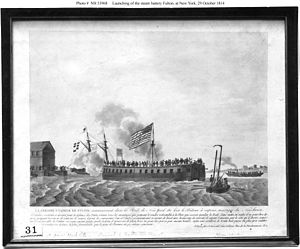- Demologos
-
For other ships of the same name, see USS Fulton.

Demologos, first steam warshipCareer (United States of America) 
Name: Demologos or Fulton Ordered: 1814 Builder: Robert Fulton Laid down: 1814 Launched: 1815 Commissioned: 1816 Fate: Blown up, 4 June 1829 General characteristics Class and type: Steam battery Displacement: 1,450 tons Length: 153 ft 2 in (46.69 m) Beam: 58 ft (18 m) Draft: 13 ft (4.0 m) Propulsion: Steam, 1 cylinder 120 hp (89 kW) Speed: 5.5 knots (10.2 km/h; 6.3 mph) Armament: 16 × 32-pounder guns Demologos was the first warship to be propelled by a steam engine. She was a wooden floating battery built to defend New York Harbor from the Royal Navy during the War of 1812. The vessel was designed to a unique pattern by Robert Fulton, and was renamed Fulton after his death. Because of the prompt end of the war, Demologos never saw action, and no other ship like her was built.
Contents
History
On 9 March, 1814, Congress authorized the construction of a steam warship to be designed by Robert Fulton, a pioneer of commercial steamers in North America. The construction of the ship began on 20 June 1814, at the civilian yard of Adam and Noah Brown, and the ship was launched on 29 October. After sea trials she was delivered to the United States Navy in June 1816. The ship was never formally named; Fulton christened it Demologos or Demologus, though following his death in February 1815, the ship was named Fulton.
By the time she was completed, the war for which Demologos had been built had ended. She saw only one day of active service, when she carried President James Monroe on a tour of New York Harbor. A two-masted lateen rig was added by the orders of her first commander, Captain David Porter. In 1821 her armament and machinery were removed. The remainder of her career was spent laid up in reserve; after 1825 she served as the floating barracks for Brooklyn Navy Yard. She came to an end on 4 June 1829 in a gunpowder explosion.
Design and impact
Demologos had an entirely unique and innovative design. A catamaran, her paddlewheel was sandwiched between two hulls. Each hull was constructed 5 ft (1.5 m) thick for protection against gunfire. The steam engine, mounted below the waterline in one of the hulls, was capable of giving 5.5 knots (10.2 km/h) speed in favorable conditions. Sixteen 32-pounder guns were mounted.
Fulton's design solved several of the problems inherent in warships powered by paddlewheels which led to the adoption of the paddle-steamer as an effective warship in following decades. By placing the paddlewheel centrally, sandwiched between two hulls, Fulton protected it from gunfire; this design also allowed the ship to mount a full broadside of guns.
The steam engine offered the prospect of tactical advantage against sail-powered warships. In a calm, sailing ships depended on the manpower of their crews to tow the ship from the boats, or to kedge with anchors. Demologos, with steam, might have found it easy to outmaneuver a ship-of-the-line in calm weather.
The innovative construction and steam power also fundamentally limited the role Demologos could fill. With an unreliable engine and a hull unsuited to seaways, Demologos was unable to travel on the high seas. The United States Navy planned to build a number of similar steam batteries, but none of these plans got off the drawing board until the USS Fulton of 1837. A number of European navies also considered acquiring the Demologos, but these inquiries came to nought.
The Demologos was ultimately a dead end in the introduction of steam power to the warship. Armed paddle steamers proliferated in the 1830s and 40s as armed tugs and transports. During the Civil War, the United States Navy operated a number of iron clad steam-powered paddle-wheel gunboats as a part of the Mississippi River Squadron. Known as City class ironclad gunboats as they were named after cities on the Mississippi River or its tributaries, these ships utilized a double-hulled configuration similar to Fulton's design, with the paddle wheel in the center. The wheel was protected by armored plate, allowing full broad-sides, as well as bow and stern shots. An example, the USS Cairo, is on display at the Vicksburg National Military Park. Paddle-wheel propulsion, more usually side-paddle configurations, in military use continued until World War II with the USS Wolverine and USS Sable training aircraft carriers. These designs were typically limited to use in the Brown-water navy or on large lakes.
Steam-powered paddle wheel propulsion would ultimately be eclipsed by the introduction of the screw propeller in the 1840s, enabling steam-powered version of the ship of the line and the frigate before steam power was properly adapted for use in a Blue water navy.
References
- Canney, Donald L. The Old Steam Navy, Volume One: Frigates, Sloops, and Gunboats 1815-1885. Annapolis, Maryland: Naval Institute Press, 1990. ISBN 0870210041
- Lambert, Andrew "The Introduction of Steam" in Gardiner (ed) Steam, Steel and Shellfire: The Steam Warship 1815-1905, Conway, London 1992. ISBN 0-85177-608-6
- "Fulton", US Navy Historical Center, retrieved 25 June 2007
External links
Categories:- United States Navy steamships
- Unique ships
- Ships built in New York
- 1810s ships
Wikimedia Foundation. 2010.


